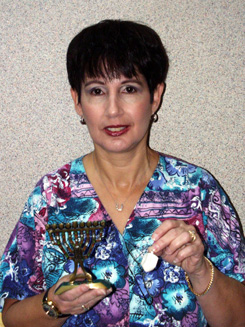 |
UNMC’s Barb Berney holds a menorah, left, and dreidel. |
Chanukah (or Hanukah) is the Hebrew word for rededication. Today the word represents an annual festival of the Jewish people that is celebrated for eight nights. This year, the observance begins Nov. 29 at sundown. Chanukah generally begins on the 25th day of Kislev, the third month of the Jewish calendar, a date that corresponds approximately to Dec. 25 on the Gregorian calendar. In the Jewish community, Chanukah is known as the Festival of Lights.
The history
One of the Chanukah celebrants is Barb Berney, UNMC clerical assistant in the department of regional pathology services, who offered a summary history of one of the most sacred observances of the Jewish people.
Chanukah commemorates the rededication of the temple of Jerusalem by Judah Maccabee, a Jewish general, after Jewish military forces drove the Syrian army out of Israel and recaptured the Holy Temple, Berney said. During the occupation, Syria’s King Antiochus forbade the practice of Judaism and dedicated the Jewish Holy Temple in Jerusalem to the worship of the pagan Greek god Zeus Olympius. Judah Maccabee and his four brothers formed a resistance army called the ‘Maccabees,’ and after three years of war against the Syrians, reclaimed Israel for the Jewish people.
The Maccabees immediately purged the Temple of all pagan symbols and statues and rededicated the Temple to Judaism on the 25th day of the month of Kislev. When they finished cleaning the Temple, the Maccabees wanted to light the eternal light, known as the N’er Tamid, which is present in every Jewish house of worship. Once lit, the oil lamp should never be extinguished.
But only a tiny jug of the consecrated oil used for the eternal light could be found — only enough for a single day. The oil lamp was filled and lit and miraculously burned for eight days. The Festival of lights last eight days to commemorate the miracle of the oil.
The celebration
“Today in America, Chanukah is a festive family occasion where people give and receive gifts, decorate the house, entertain friends and family, eat special foods, and light the holiday candelabra called the Menorah,” Berney said. “The Menorah has nine holders. The ninth one is the middle one called the Shamash and this one is used to light the other eight other holders — one light each night for eight nights. A blessing is said each night as the candles are lit. Children receive small gifts or money every evening after the candles are lit, then songs are sung and foods such as latkes (potato pancakes) are fried in oil to commemorate the miracle of the oil.”
The dreidel
One of the best known symbols of Chanukah – especially for Jewish children — is the dreidel, a four-sided spinning top with a Hebrew letter on each side. The four letters in tandem mean “A great miracle happened there.” Individually, the symbols stand for “nothing happens (next player spins), all (player takes entire pot), half (player takes half the pot) or put in (player must put one token in the pot).” Players use pennies, nuts, raisins or chocolate coins as tokens or chips. Dreidel is a joyful guessing game to see which letter to will appear and how much candy and coins can be claimed.
The calendar
“The Jewish calendar is completely unrelated to the western Gregorian calendar,” Berney said. “The Jewish calendar dates back more than 5,000 years. Chanukah begins very early this year, but usually is very close to Christmas Day. Many Jewish homes will be displaying outside decorations including menorahs and dreidels that light up, as well as strands of blue and white lights.”